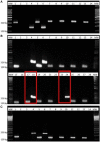Detection of Benzimidazole Resistance-Associated Single-Nucleotide Polymorphisms in the Beta-Tubulin Gene in Trichuris trichiura from Brazilian Populations
- PMID: 35895340
- PMCID: PMC9490667
- DOI: 10.4269/ajtmh.22-0157
Detection of Benzimidazole Resistance-Associated Single-Nucleotide Polymorphisms in the Beta-Tubulin Gene in Trichuris trichiura from Brazilian Populations
Abstract
Preventive chemotherapy is recommended by the WHO as the main strategy for controlling infections caused by nematodes in humans, aiming to eliminate the morbidity associated with these infections. This strategy consists of routine periodic administration of benzimidazoles, among other drugs. Although these drugs decrease the intensity of infections, they have the potential to exert selection pressure for genotypes bearing mutations associated with drug resistance, which may result in the establishment of resistant worm populations. There is evidence in the literature of resistance to these drugs in nematodes that infect humans, including in the species Trichuris trichiura. Single-nucleotide polymorphisms (SNPs) in the beta-tubulin gene located at codons 167, 198, and 200 are associated with the mechanism of resistance to benzimidazoles in nematodes. Here, we standardized a molecular technique based on an amplification refractory mutation system-polymerase chain reaction (ARMS-PCR) to analyze codons 167, 198, and 200 of T. trichiura. The ARMS-PCR methodology was successfully established to evaluate the codons of interest. A total of 420 samples of individual eggs were analyzed from populations obtained from five Brazilian states. A mutation in codon 198 was observed at a frequency of 4.8% (20/420), while for the other two codons, no polymorphism was observed. This is the first report of the presence of this mutation in populations of T. trichiura in Brazil. This fact and the emergence of the problem already observed in other species reinforces the need for regular monitoring of SNPs related to benzimidazole resistance using techniques that are highly sensitive and specific.
Figures



Similar articles
-
Deep-amplicon sequencing of the complete beta-tubulin gene in Trichuris trichiura before and after albendazole treatment.Int J Parasitol Drugs Drug Resist. 2024 Dec;26:100570. doi: 10.1016/j.ijpddr.2024.100570. Epub 2024 Nov 12. Int J Parasitol Drugs Drug Resist. 2024. PMID: 39546832 Free PMC article.
-
Assays to detect beta-tubulin codon 200 polymorphism in Trichuris trichiura and Ascaris lumbricoides.PLoS Negl Trop Dis. 2009;3(3):e397. doi: 10.1371/journal.pntd.0000397. Epub 2009 Mar 24. PLoS Negl Trop Dis. 2009. PMID: 19308251 Free PMC article.
-
PCR-RFLP screening of polymorphisms associated with benzimidazole resistance in Necator americanus and Ascaris lumbricoides from different geographical regions in Brazil.PLoS Negl Trop Dis. 2018 Sep 17;12(9):e0006766. doi: 10.1371/journal.pntd.0006766. eCollection 2018 Sep. PLoS Negl Trop Dis. 2018. PMID: 30222749 Free PMC article.
-
First identification of the benzimidazole resistance-associated F200Y SNP in the beta-tubulin gene in Ascaris lumbricoides.PLoS One. 2019 Oct 17;14(10):e0224108. doi: 10.1371/journal.pone.0224108. eCollection 2019. PLoS One. 2019. PMID: 31622428 Free PMC article.
-
Single nucleotide polymorphism (SNP) markers for benzimidazole resistance in veterinary nematodes.Parasitology. 2007;134(Pt 8):1077-86. doi: 10.1017/S0031182007000054. Parasitology. 2007. PMID: 17608967 Review.
Cited by
-
A drug repurposing screen for whipworms informed by comparative genomics.PLoS Negl Trop Dis. 2023 Sep 5;17(9):e0011205. doi: 10.1371/journal.pntd.0011205. eCollection 2023 Sep. PLoS Negl Trop Dis. 2023. PMID: 37669291 Free PMC article.
-
The impact of an integrated intervention program combining drug therapy with water, sanitation, and hygiene (WASH) education on reinfection with intestinal parasitic infections among the Karen hill tribe in northern Thailand.Parasit Vectors. 2024 Dec 29;17(1):544. doi: 10.1186/s13071-024-06611-z. Parasit Vectors. 2024. PMID: 39734215 Free PMC article.
-
Deep-amplicon sequencing of the complete beta-tubulin gene in Trichuris trichiura before and after albendazole treatment.Int J Parasitol Drugs Drug Resist. 2024 Dec;26:100570. doi: 10.1016/j.ijpddr.2024.100570. Epub 2024 Nov 12. Int J Parasitol Drugs Drug Resist. 2024. PMID: 39546832 Free PMC article.
-
A combined treatment regimen for Trichuris rhinopiptheroxella infection in Rhinopithecus roxellana in southern China.Int J Parasitol Parasites Wildl. 2025 Jan 3;26:101036. doi: 10.1016/j.ijppaw.2025.101036. eCollection 2025 Apr. Int J Parasitol Parasites Wildl. 2025. PMID: 39867133 Free PMC article.
-
New Insights on Tools for Detecting β-Tubulin Polymorphisms in Trichuris trichiura Using rhAmpTM SNP Genotyping.Animals (Basel). 2024 May 23;14(11):1545. doi: 10.3390/ani14111545. Animals (Basel). 2024. PMID: 38891592 Free PMC article.
References
-
- Stephenson LS, Holland CV, Cooper ES, 2000. The public health significance of Trichuris trichiura . Parasitology 121 (Suppl): S73–S95. - PubMed
-
- Crowe AL Smith P Ward L Currie BJ Baird R , 2014. Decreasing prevalence of Trichuris trichiura (whipworm) in the Northern Territory from 2002 to 2012. Med J Aust 200: 286–289. - PubMed
-
- Campbell SJ Nery SV McCarthy JS Gray DJ Soares Magalhães RJ Clements A , 2016. A critical appraisal of control strategies for soil-transmitted helminths. Trends Parasitol 32: 97–107. - PubMed
-
- Jourdan PM Lamberton P Fenwick A Addiss DG , 2018. Soil-transmitted helminth infections. Lancet 391: 252–265. - PubMed
LinkOut - more resources
Full Text Sources

